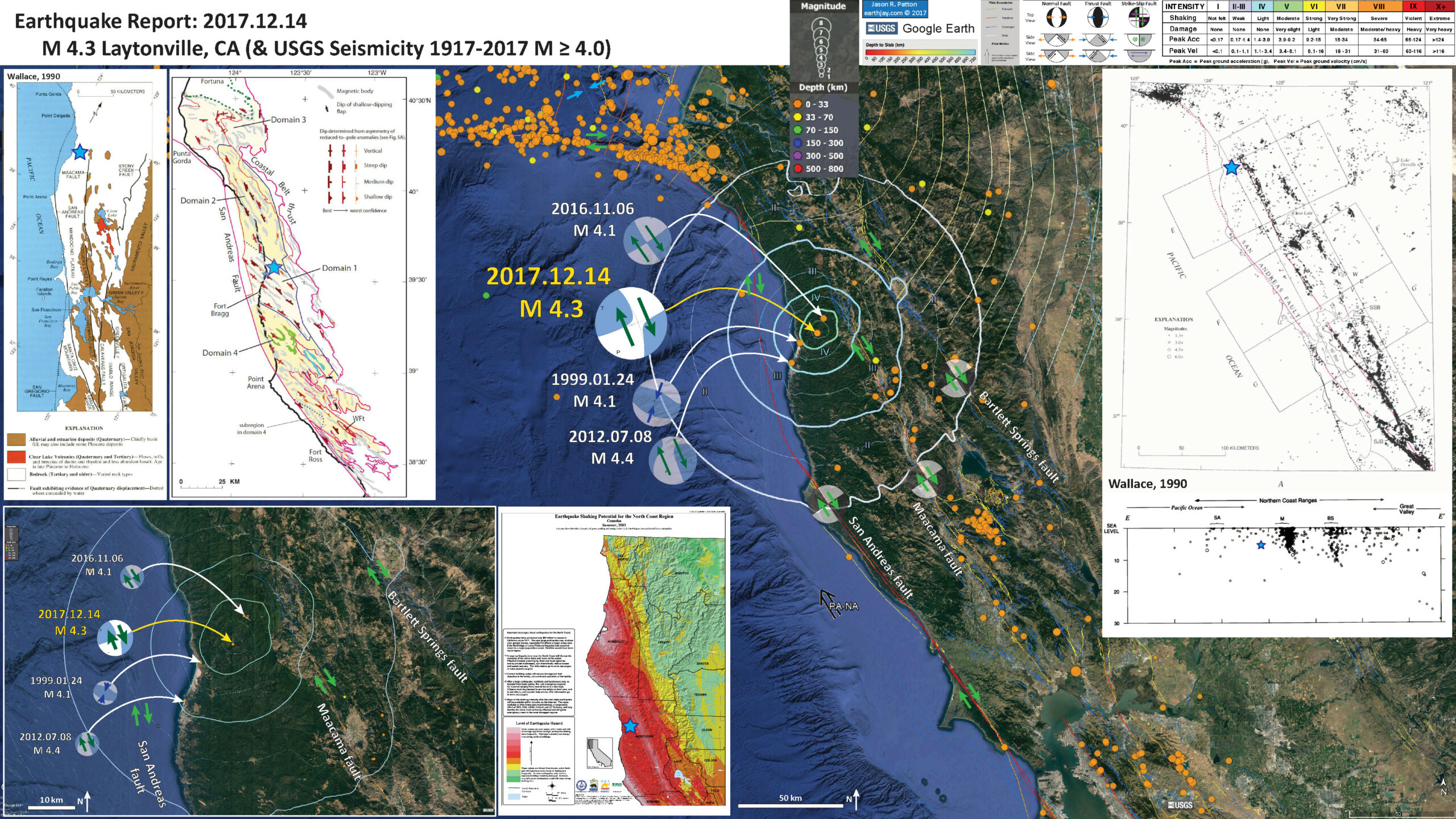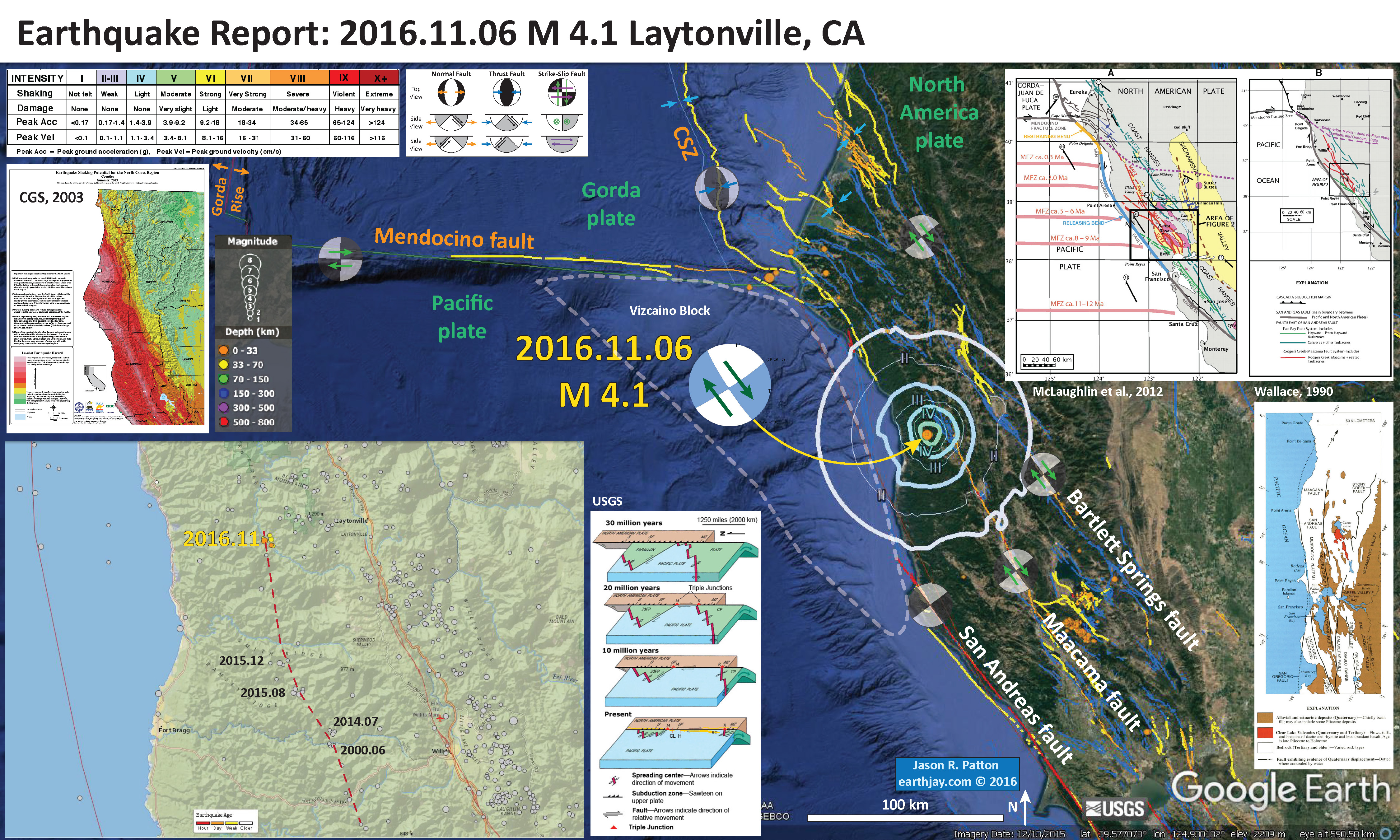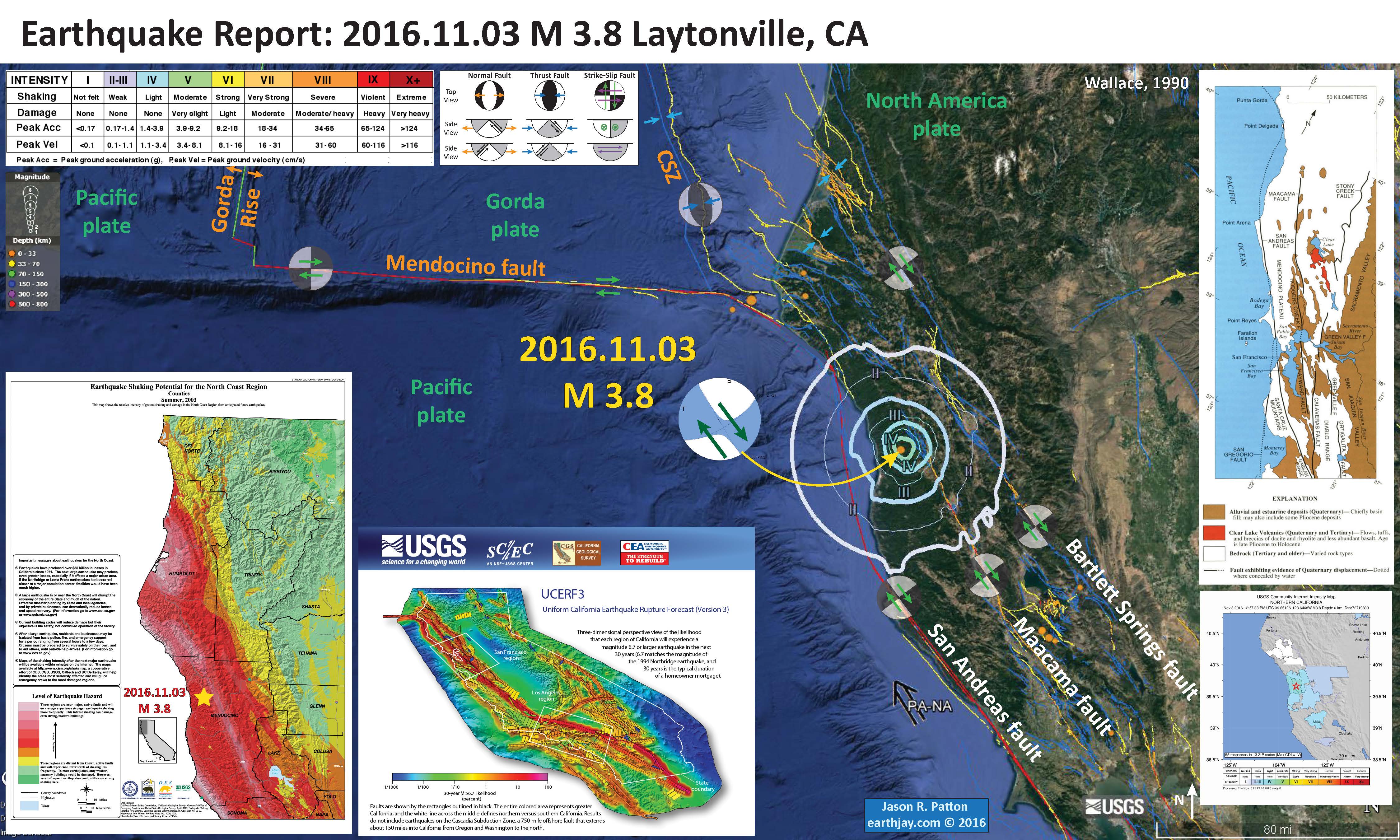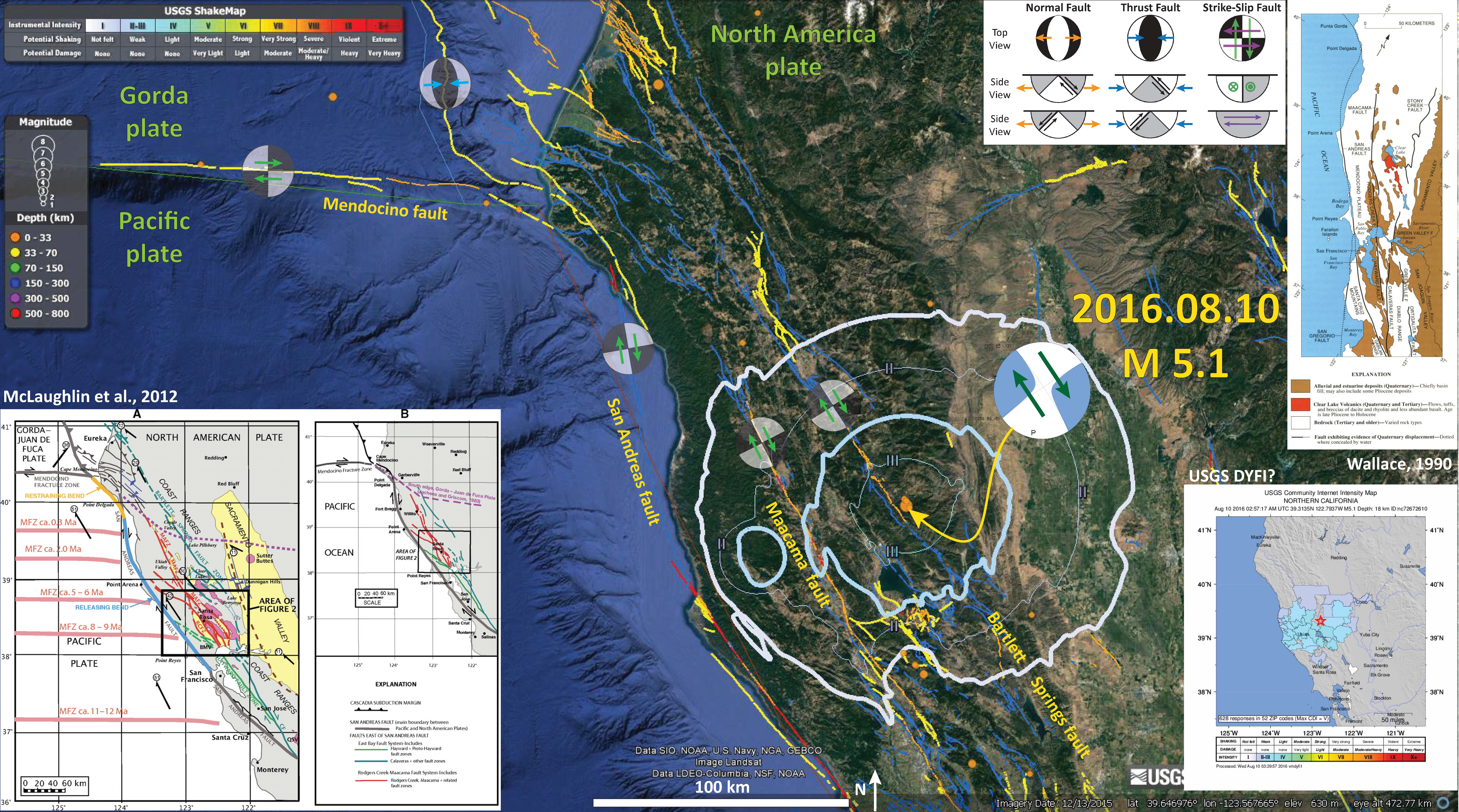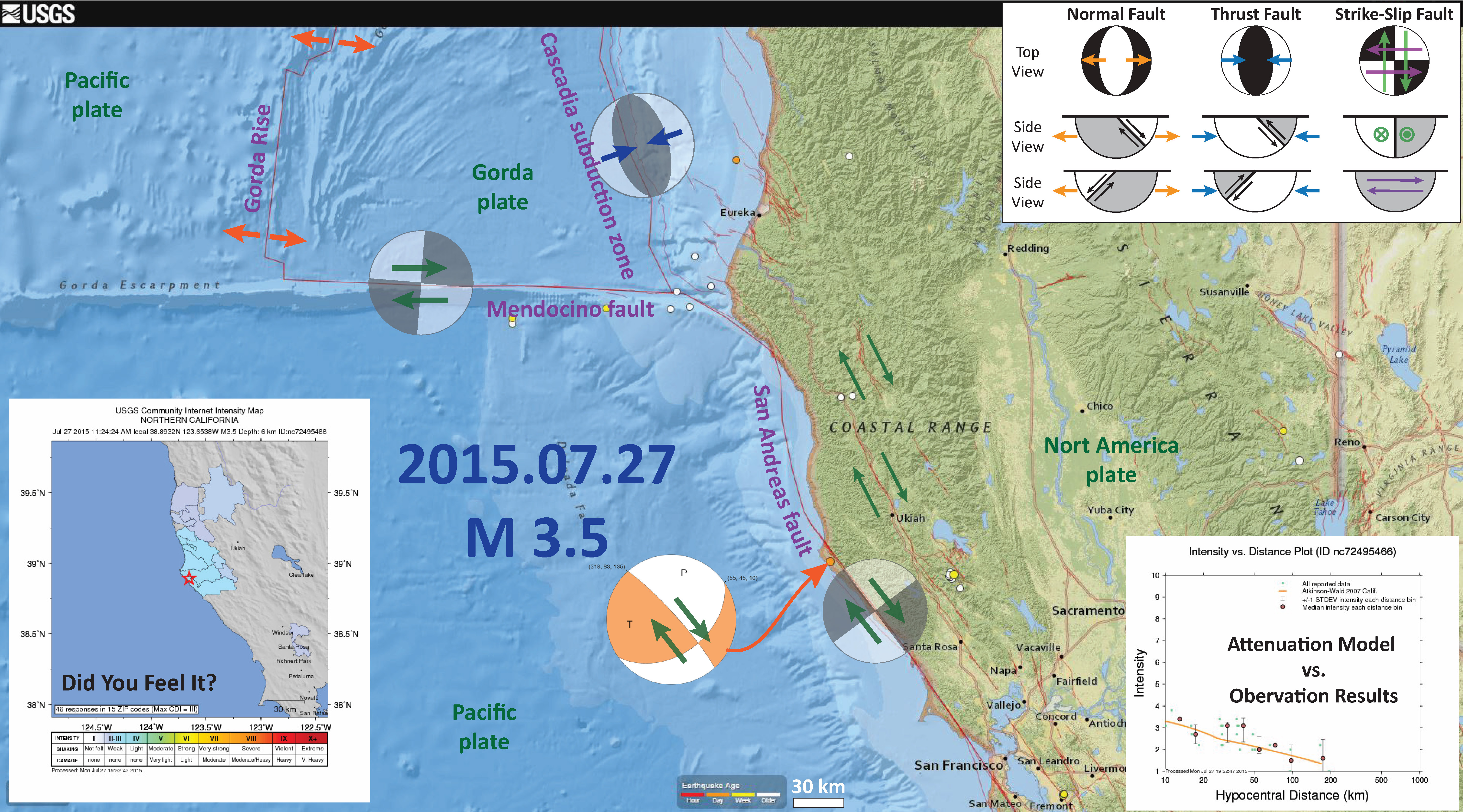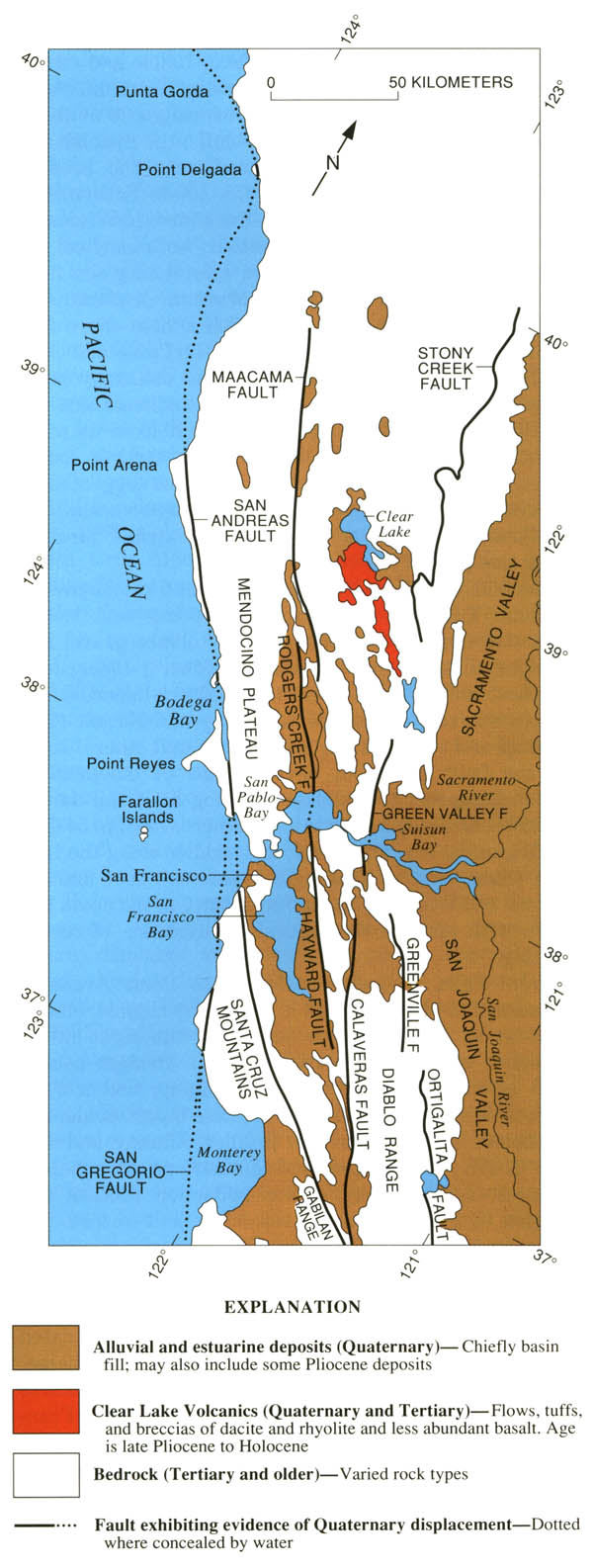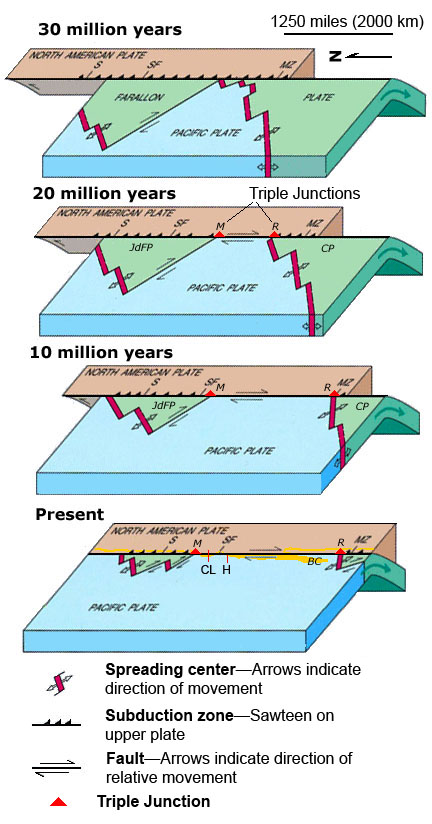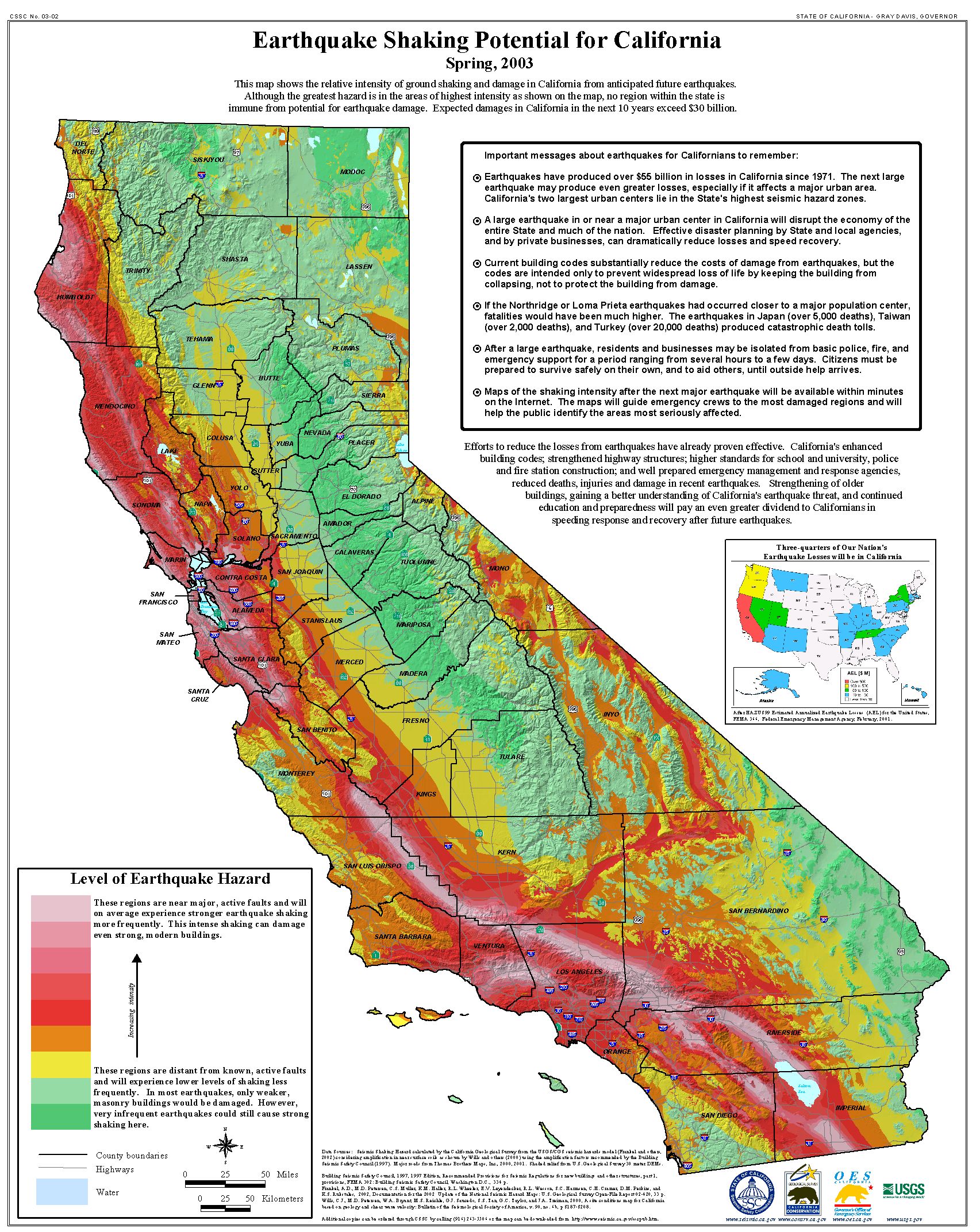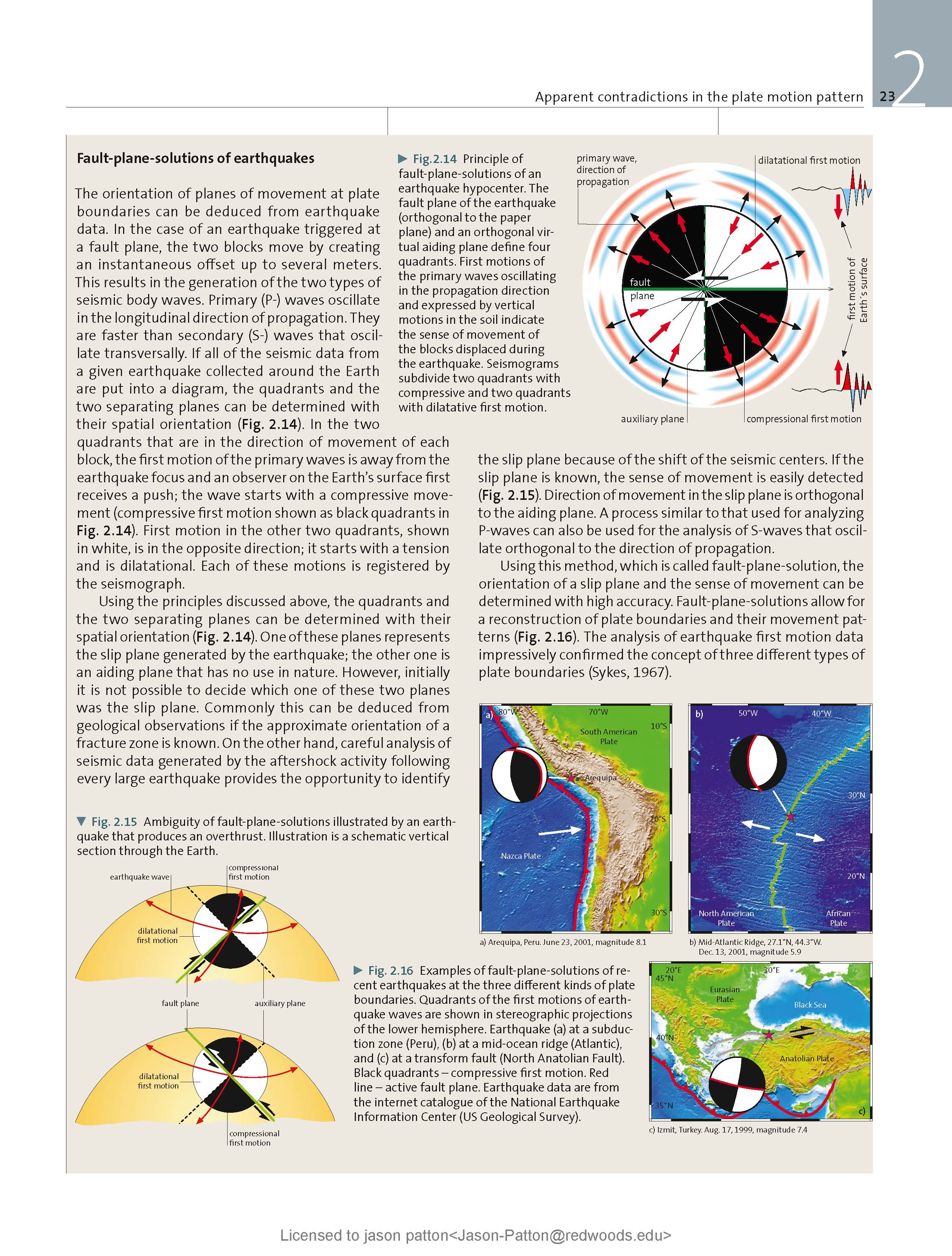This morning there was a small earthquake in a region of northern California between two major faults that are part of the Pacific-North America plate boundary. The M 4.3 earthquake occurred between the San Andreas fault (SAF) to the west and the Maacama fault (MF) to the east. There are no mapped earthquake faults in this region.
The San Andreas fault is a right-lateral strike-slip transform plate boundary between the Pacific and North America plates. The plate boundary is composed of faults that are parallel to sub-parallel to the SAF and extend from the west coast of CA to the Wasatch fault (WF) system in central Utah (the WF runs through Salt Lake City and is expressed by the mountain range on the east side of the basin that Salt Lake City is built within).
About 75% of the relative plate motion is accommodated along the SAF and its synthetic sister faults in the northern CA region. The rest of the plate boundary motion is accommodated along the Eastern CA shear zone and Walker Lane, along with the Central Nevada Seismic Belt, and the Wasatch fault systems. In Northern CA, there is about 33-37 mm/yr strain accumulated on the SAF plate boundary system. About 18-25 mm/yr is on the SAF, 8-11 mm/yr on the MF, and 5-7 mm/yr on the Bartlett Springs fault system (Geist and Andrews, 2000).
The three main faults in the region north of San Francisco are the SAF, the MF, and the Bartlett Springs fault (BSF). I also place a graphical depiction of the USGS moment tensor for this earthquake. The SAF, MF, and BSF are all right lateral strike-slip fault systems. There are no active faults mapped in the region of Sunday’s epicenter, but I interpret this earthquake to have right-lateral slip. Without more seismicity or mapped faults to suggest otherwise, this is a reasonable interpretation.
Below is my interpretive poster for this earthquake.
I plot the seismicity from the past month, with color representing depth and diameter representing magnitude (see legend). I include earthquake epicenters from 1917-2017 with magnitudes M > 4.0.
I use the USGS Quaternary fault and fold database for the faults. I outlined the Vizcaino Block, which many interpret to be a prehistoric subduction zone accretionary prism from a time before the San Andreas existed.
I plot the USGS fault plane solutions (moment tensors in blue) for some relevant historic earthquakes.
- I placed a moment tensor / focal mechanism legend on the poster. There is more material from the USGS web sites about moment tensors and focal mechanisms (the beach ball symbols). Both moment tensors and focal mechanisms are solutions to seismologic data that reveal two possible interpretations for fault orientation and sense of motion. One must use other information, like the regional tectonics, to interpret which of the two possibilities is more likely. Based upon the tectonics associated with the San Andreas and Maacama faults, I interpret this M 4.3 earthquake to be a right-lateral strike-slip fault.
- I also include the shaking intensity contours on the map. These use the Modified Mercalli Intensity Scale (MMI; see the legend on the map). This is based upon a computer model estimate of ground motions, different from the “Did You Feel It?” estimate of ground motions that is actually based on real observations. The MMI is a qualitative measure of shaking intensity. More on the MMI scale can be found here and here. This is based upon a computer model estimate of ground motions, different from the “Did You Feel It?” estimate of ground motions that is actually based on real observations.
- I include the slab contours plotted (McCrory et al., 2012), which are contours that represent the depth to the subduction zone fault. These are mostly based upon seismicity. The depths of the earthquakes have considerable error and do not all occur along the subduction zone faults, so these slab contours are simply the best estimate for the location of the fault.
- Here are the USGS pages for the main earthquake in this sequence.
- 2017.12.14 M 4.3
- 2016.11.06 M 4.1
- 2012.07.08 M 4.4
- 1999.01.24 M 4.1
-
I include some inset figures.
- In the upper right corner I include a map and cross section from Wallace (1990). The map shows earthquake epicenters, the major faults, and outlines delineating the regions from which seismicity is plotted in various cross sectional views. Below the map is the cross section E-E.’ Seismicity associated with the MF and Bartlett Springs fault are fairly obvious, while seismicity associated with the SAF is less localized along the fault (probably because the fault is offshore, the smaller magnitude seismicity does not plot here). I place blue stars on the map and on the cross section, in the general location of today’s M 4.3 earthquake.
- In the upper left corner I include generalized fault map of northern California from Wallace (1990). I place a blue star in the general location of today’s M 4.3 earthquake.
- To the right of the Wallace (1990) map, is a figure from Langenheim et al., 2013. Langenheim et al. (2013) used magnetic anomalies to break out structural domains within the Cretaceous Franciscan Formation, the main basement geology in this region of northern California. There are some folds in the Franciscan Formation, with dips interpreted from the anomaly data. Today’s M 4.3 earthquake (the larger blue star) is located along the boundary of domains 1 and 2. The 1999.01.24 M 4.1 earthquake (smaller blue star)is within domain 1, is a thrust earthquake, and is oriented correctly to be associated with the thrust faults here. Perhaps these faults are being reactivated in the modern SAF dextral regime.
- In the lower left corner I include a larger scale map showing the details of the mapped faults.
- To the right of this large scale map, I include the Earthquake Shaking Potential map from the state of California. This is a probabilistic seismic hazard map, basically a map that shows the likelihood that there will be shaking of a given amount over a period of time. More can be found from the California Geological Survey here. I place a blue star in the approximate location of today’s earthquake.
Below are some earthquake report posters for earthquakes in this region.
- About a year ago there was an earthquake in this same region. Here is my earthquake report for that earthquake.
- Earlier in November 2016, there was an earthquake in this region. Below is my interpretive poster for that earthquake. Here is my Earthquake Report.
- Earlier the year in 2016, there was an earthquake in this region, along the BSF. Below is my interpretive poster for that earthquake. Here is my Earthquake Report.
- In 2015 there was an earthquake in this region. Below is my interpretive poster for that earthquake. Here is my Earthquake Report.
- There was a recent earthquake along the San Andreas fault in the Point Arena region in July of 2015.
- I place a map shows the configuration of faults in central (San Francisco) and northern (Point Delgada – Punta Gorda) CA (Wallace, 1990). Here is the caption for this map, that is on the lower left corner of my map. Below the citation is this map presented on its own.
Geologic sketch map of the northern Coast Ranges, central California, showing faults with Quaternary activity and basin deposits in northern section of the San Andreas fault system. Fault patterns are generalized, and only major faults are shown. Several Quaternary basins are fault bounded and aligned parallel to strike-slip faults, a relation most apparent along the Hayward-Rodgers Creek-Maacama fault trend.
- Here is a map from McLaughlin et al. (2012) that shows the regional faulting. I include the figure caption as a blockquote below.
Maps showing the regional setting of the Rodgers Creek–Maacama fault system and the San Andreas fault in northern California. (A) The Maacama (MAFZ) and Rodgers Creek (RCFZ) fault zones and related faults (dark red) are compared to the San Andreas fault, former and present positions of the Mendocino Fracture Zone (MFZ; light red, offshore), and other structural features of northern California. Other faults east of the San Andreas fault that are part of the wide transform margin are collectively referred to as the East Bay fault system and include the Hayward and proto-Hayward fault zones (green) and the Calaveras (CF), Bartlett Springs, and several other faults (teal). Fold axes (dark blue) delineate features associated with compression along the northern and eastern sides of the Coast Ranges. Dashed brown line marks inferred location of the buried tip of an east-directed tectonic wedge system along the boundary between the Coast Ranges and Great Valley (Wentworth et al., 1984; Wentworth and Zoback, 1990). Dotted purple line shows the underthrust south edge of the Gorda–Juan de Fuca plate, based on gravity and aeromagnetic data (Jachens and Griscom, 1983). Late Cenozoic volcanic rocks are shown in pink; structural basins associated with strike-slip faulting and Sacramento Valley are shown in yellow. Motions of major fault blocks and plates relative to fi xed North America, from global positioning system and paleomagnetic studies (Argus and Gordon, 2001; Wells and Simpson, 2001; U.S. Geological Survey, 2010), shown with thick black arrows; circled numbers denote rate (in mm/yr). Restraining bend segment of the northern San Andreas fault is shown in orange; releasing bend segment is in light blue. Additional abbreviations: BMV—Burdell Mountain Volcanics; QSV—Quien Sabe Volcanics. (B) Simplifi ed map of color-coded faults in A, delineating the principal fault systems and zones referred to in this paper.
- Here is the figure showing the evolution of the SAF since its inception about 29 Ma. I include the USGS figure caption below as a blockquote.
EVOLUTION OF THE SAN ANDREAS FAULT.
This series of block diagrams shows how the subduction zone along the west coast of North America transformed into the San Andreas Fault from 30 million years ago to the present. Starting at 30 million years ago, the westward- moving North American Plate began to override the spreading ridge between the Farallon Plate and the Pacific Plate. This action divided the Farallon Plate into two smaller plates, the northern Juan de Fuca Plate (JdFP) and the southern Cocos Plate (CP). By 20 million years ago, two triple junctions began to migrate north and south along the western margin of the West Coast. (Triple junctions are intersections between three tectonic plates; shown as red triangles in the diagrams.) The change in plate configuration as the North American Plate began to encounter the Pacific Plate resulted in the formation of the San Andreas Fault. The northern Mendicino Triple Junction (M) migrated through the San Francisco Bay region roughly 12 to 5 million years ago and is presently located off the coast of northern California, roughly midway between San Francisco (SF) and Seattle (S). The Mendicino Triple Junction represents the intersection of the North American, Pacific, and Juan de Fuca Plates. The southern Rivera Triple Junction (R) is presently located in the Pacific Ocean between Baja California (BC) and Manzanillo, Mexico (MZ). Evidence of the migration of the Mendicino Triple Junction northward through the San Francisco Bay region is preserved as a series of volcanic centers that grow progressively younger toward the north. Volcanic rocks in the Hollister region are roughly 12 million years old whereas the volcanic rocks in the Sonoma-Clear Lake region north of San Francisco Bay range from only few million to as little as 10,000 years old. Both of these volcanic areas and older volcanic rocks in the region are offset by the modern regional fault system. (Image modified after original illustration by Irwin, 1990 and Stoffer, 2006.)
- Here is a map that shows the shaking potential for earthquakes in CA. This comes from the state of California here.
Earthquake shaking hazards are calculated by projecting earthquake rates based on earthquake history and fault slip rates, the same data used for calculating earthquake probabilities. New fault parameters have been developed for these calculations and are included in the report of the Working Group on California Earthquake Probabilities. Calculations of earthquake shaking hazard for California are part of a cooperative project between USGS and CGS, and are part of the National Seismic Hazard Maps. CGS Map Sheet 48 (revised 2008) shows potential seismic shaking based on National Seismic Hazard Map calculations plus amplification of seismic shaking due to the near surface soils.
- Here are three figures from Langenheim et al. (2013). The first one shows the geology of the region. The second map shows the magnetic anomaly data and the second map shows how they interpreted the magnetic anomaly data to reveal different tectonic domains in the Franciscan Formation.
Map showing location and geologic setting of the Franciscan Coastal Belt in the northern California Coast Ranges. Inset shows magnetic anomalies (in magenta) of Figure 2 in and near the Coastal Belt, mapped occurrences of basalt (black dots and areas), and associated fossil localities (numbered white X’s; listed in Table 1). Map units: fc—Franciscan False Cape terrane; KRt—Franciscan King Range terrane; Cob—Franciscan Coastal Belt, undivided; Yg—Franciscan Yager terrane; Cnb— Franciscan Central Belt; Eb—Franciscan Eastern Belt; um—ultramafi c rocks; MTJ— Mendocino triple junction; GVg—Great Valley Group; T—Tertiary cover; Q—alluvium, largely Quaternary. Stippled pattern near Fort Ross shows outcrop of Ohlson Ranch Formation. Magenta arrows labeled PAC and GOR show relative plate motion of Pacific and Gorda plates, respectively, relative to the North American plate (McCrory, 2000). Tiny box labeled MH—Marin Headlands (area of Fig. 8). Coastal Belt thrust is shown with thrust teeth. Geology was compiled and simplifi ed from Jennings (1977), Blake et al. (1992), Blake et al. (2002), Jayko et al. (1989), McLaughlin et al. (2000), U.S. Geological Survey and California Geological Survey (2006), and geologic mapping by R.J. McLaughlin northeast of Clear Lake and south of Willits. Southern part of the Coastal Belt thrust west and south of Willits is from (1) mapping by McLaughlin, interpretation of aeromagnetic anomalies, and 1:62,500 scale topography, and (2) that east of Point Arena is from photogeologic interpretation that resulted in a greater extent of mélange assigned to the Central Belt.
Filtered magnetic map of the Coastal Belt. See Langenheim et al. (2011) for details of filtering that places anomalies over magnetic sources and enhances anomalies for which sources are exposed or near surface. Magenta lines—margins of the belt, with the San Andreas fault on the west and the Coastal Belt thrust and other faults on the east. Dashed dark green lines—depositional contacts. Red lines— boundaries between the terranes of the Coastal Belt: Coastal Belt, undivided (Cob), False Cape terrane (fc), King Range terrane (KRt), and Yager terrane (Yg). The Wheatfield Fork terrane (WFt) is too narrow to show at the scale of the figure, but its extent along the eastern boundary of the Coastal Belt is circled in dark blue. Thin dark blue dotted lines separate structural domains discussed in text and shown in figure 6. Blue line—profile location of model shown in Figure 5B.
Structural domains and dips interpreted from filtered magnetic anomalies (Fig. 2). Layer dip from asymmetry of magnetic anomaly is shown. Dark blue lines separate domains discussed in text. Anomalies within area east of the Coastal Belt thrust may be caused by magnetic layers in the Coastal Belt beneath a thin sheet of Central Belt rocks in the hanging wall of the thrust. Anomalies colored green, blue, and lavender are discussed in text. WFt— Wheatfield Fork terrane. Dashed green line is outline of onshore Eel River basin.
- There are three types of earthquakes, strike-slip, compressional (reverse or thrust, depending upon the dip of the fault), and extensional (normal). Here is are some animations of these three types of earthquake faults. Many of the earthquakes people are familiar with in the Mendocino triple junction region are either compressional or strike slip. The following three animations are from IRIS.
- Strike Slip:
- Compressional:
- Extensional:
- This figure shows what a transform plate boundary fault is. Looking down from outer space, the crust on either side of the fault moves side-by-side. When one is standing on the ground, on one side of the fault, looking across the fault as it moves… If the crust on the other side of the fault moves to the right, the fault is a “right lateral” strike slip fault. The Mendocino and San Andreas faults are right-lateral (dextral) strike-slip faults. I believe this is from Pearson Higher Ed.
- For more on the graphical representation of moment tensors and focal mechnisms, check this IRIS video out:
- Here is a fantastic infographic from Frisch et al. (2011). This figure shows some examples of earthquakes in different plate tectonic settings, and what their fault plane solutions are. There is a cross section showing these focal mechanisms for a thrust or reverse earthquake. The upper right corner includes my favorite figure of all time. This shows the first motion (up or down) for each of the four quadrants. This figure also shows how the amplitude of the seismic waves are greatest (generally) in the middle of the quadrant and decrease to zero at the nodal planes (the boundary of each quadrant).
- 2017.12.14 M 4.3 Laytonville
- 2016.11.06 M 4.1 Laytonville, CA
- 2016.11.03 M 3.8 Laytonville, CA
- 2016.08.10 M 5.1 Lake Pillsbury, CA
- 2015.08.30 M 3.6 Mendocino County, CA
- 2015.07.27 M 3.5 Point Arena, CA
- 2016.02.23 M 4.9 Bakersfield
- 2015.12.30 M 4.4 San Bernardino, CA
- 2015.05.03 M 3.8 Los Angeles, CA
- 2015.04.13 M 3.3 Los Angeles, CA
- 2014.04.01 M 5.1 La Habra p-3
- 2014.03.29 M 5.1 La Habra p-2
- 2014.03.28 M 5.1 La Habra p-1
- 2016.08.04 M 4.5 Honey Lake, CA
San Andreas fault earthquake reports
General Overview
Earthquake Reports
Northern CA
Southern CA
Eastern CA
- Geist, E.L. and Andrews D.J., 2000. Slip rates on San Francisco Bay area faults from anelastic deformation of the continental lithosphere, Journal of Geophysical Research, v. 105, no. B11, p. 25,543-25,552.
- Irwin, W.P., 1990. Quaternary deformation, in Wallace, R.E. (ed.), 1990, The San Andreas Fault system, California: U.S. Geological Survey Professional Paper 1515, online at: http://pubs.usgs.gov/pp/1990/1515/
- Langenheim, V.E., Jachens, R.C., Wentworht, C.M., and McLaughlin, R.J., 2012. Previously unrecognized regional structure of the Coastal Belt of the Franciscan Complex, northern California, revealed by magnetic data in Geosphere, v. 9, no. 6, doi:10.1130/GES0094
- McLaughlin, R.J., Sarna-Wojcicki, A.M., Wagner, D.L., Fleck, R.J., Langenheim, V.E., Jachens, R.C., Clahan, K., and Allen, J.R., 2012. Evolution of the Rodgers Creek–Maacama right-lateral fault system and associated basins east of the northward-migrating Mendocino Triple Junction, northern California in Geosphere, v. 8, no. 2., p. 342-373.
- McCrory, P.A.,. Blair, J.L., Waldhauser, F., kand Oppenheimer, D.H., 2012. Juan de Fuca slab geometry and its relation to Wadati-Benioff zone seismicity in JGR, v. 117, B09306, doi:10.1029/2012JB009407.
- Stoffer, P.W., 2006, Where’s the San Andreas Fault? A guidebook to tracing the fault on public lands in the San Francisco Bay region: U.S. Geological Survey General Interest Publication 16, 123 p., online at http://pubs.usgs.gov/gip/2006/16/
- Wallace, Robert E., ed., 1990, The San Andreas fault system, California: U.S. Geological Survey Professional Paper 1515, 283 p. [https://pubs.er.usgs.gov/publication/pp1515].
